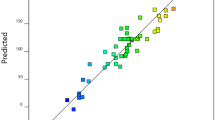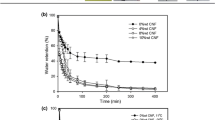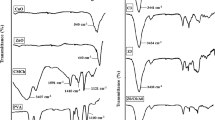Abstract
To develop a new drug delivery approach, carboxymethyl cellulose/Cu bio-nanocomposite hydrogels were successfully prepared in situ during the formation of Cu nanoparticles within swollen carboxymethyl cellulose hydrogels. The resulting hydrogels were examined by running various experimental procedures such as FT-IR, XRD, and SEM. XRD analysis confirmed the formation of Cu nanoparticles in the hydrogel matrix, while SEM micrographs showed that nanoparticles ranged from 36 to 69 nm within the same matrix. It was shown that increased Cu2+ concentration led to increased number of Cu nanoparticles. The swelling behavior of the bio-nanocomposite hydrogels was studied at pH 2.1 and 7.4, and exhibited a pH-sensitive swelling ratio, compared with the neat carboxymethyl cellulose hydrogel. The antibacterial activity of the bio-nanocomposite hydrogels was examined and mechanisms involved in their synthesis were reported; the results showed an excellent antibacterial behavior of the bio-nanocomposite hydrogel. In vitro drug release tests were carried out to assess the effectiveness of this novel type of bio-nanocomposite as a controlled drug delivery system. Sustained and controlled drug releases were observed for Cu nanoparticles containing carboxymethyl cellulose, which increased with increases in Cu nanoparticle content.
Lay Summary
The objective of this study was to prepare and characterize a group of carboxymethyl cellulose hydrogels containing copper nanoparticles. Novel carboxymethyl cellulose/Cu nanocomposite hydrogels were successfully prepared by in situ formation of Cu nanoparticles in the carboxymethyl cellulose hydrogel matrix. The effect of the concentration of the Cu nanoparticles on the swelling and drug release behavior and antibacterial activity for the Gram-negative Escherichia coli and Gram-positive Staphylococcus aureus bacteria was investigated.








Similar content being viewed by others
References
Gholamali I, Hosseini SN, Alipour E, Yadollahi M. Preparation and characterization of oxidized starch/CuO nanocomposite hydrogels applicable in a drug delivery system. Starch/Stärke. 2019;71(3–4).
Ullah F, Othman MBH, Javed F, Ahmad Z, Akil HM. Classification, processing and application of hydrogels: a review. Mater Sci Eng C. 2015;57:414–33.
Wu T, Li Y, Lee DS. Chitosan-based composite hydrogels for biomedical applications. Macromol Res. 2017;25(6):480–8.
Namazi H, Rakhshaei R, Hamishehkar H, Samadi Kafil H. Antibiotic loaded carboxymethyl cellulose/MCM-41 nanocomposite hydrogel films as potential wound dressing. Int J Biol Macromol. 2016;85:327–34.
Park SA, Lee SH, Kim WD. Fabrication of hydrogel scaffolds using rapid prototyping for soft tissue engineering. Macromol Res. 2011;19(7):694–8.
Van Vlierberghe S, Dubruel P, Schacht E. Biopolymer-based hydrogels asscaffolds for tissue engineering applications: a review. Biomacromolecules. 2011;12:1387–408.
Hoare TR, Kohane DS. Hydrogels in drug delivery: progress and challenges. Polym. 2008;49:1993–2007.
Yadollahi M, Namazi H. Synthesis and characterization of carboxymethyl cellulose/ layered double hydroxide nanocomposites. J Nanopart Res. 2013;15:1563–72.
Yadollahi M, Namazi H, Barkhordari S. Preparation and properties of carboxymethyl cellulose/layered double hydroxide bionanocomposite films. Carbohydr Polym. 2014;108:83–9.
Barkhordari S, Yadollahi M, Namazi H. pH sensitive nanocomposite hydrogel beads based on carboxymethyl cellulose/layered double hydroxide as drug delivery systems. J Polym Res. 2014;21(6):454–62.
Ashraf S, Park HK, Park H, Lee SH. Snapshot of phase transition in thermoresponsive hydrogel PNIPAM: role in drug delivery and tissue engineering. Macromol Res. 2016;24(4):297–304.
Jayaramudu T, Raghavendra GM, Varaprasad K, Sadiku R, Raju KM. Development of novel biodegradable Au nanocomposite hydrogels based on wheat: for inactivation of bacteria. Carbohydr Polym. 2013;92:2193–200.
Jayaramudu T, Raghavendra GM, Varaprasad K, Sadiku R, Ramam K, Raju KM. Iota-Carrageenan-based biodegradable Ag0 nanocomposite hydrogels for the inactivation of bacteria. Carbohydr Polym. 2013;95:188–94.
Khorasani MT, Joorabloo A, Moghaddam A, Shamsi H, Mansoori Moghadam Z. Incorporation of ZnO nanoparticles into heparinised polyvinyl alcohol/chitosan hydrogels for wound dressing application. Int J Biol Macromol. 2018;114:1203–15.
Song F, Li X, Wang Q, Liao L, Zhang C. Nanocomposite hydrogels and their applications in drug delivery and tissue engineering. J Biomed Nanotechnol. 2015;11:40–52.
Gholamali I, Asnaashariisfahani M, Alipour E. Silver nanoparticles incorporated in pH-sensitive nanocomposite hydrogels based on carboxymethyl chitosan-poly (vinyl alcohol) for use in a drug delivery system. Regen Eng Transl Med. 2019:1–16.
Rasoulzadeh M, Namazi H. Carboxymethyl cellulose/graphene oxide bio-nanocomposite hydrogel beads as anticancer drug carrier agent. Carbohydr Polym. 2017;168:320–6.
Yadollahi M, Gholamali I, Namazi H, Aghazadeh M. Synthesis and characterization of antibacterial carboxymethylcellulose/CuO bio-nanocomposite hydrogels. Int J Biol Macromol. 2015;73:109–14.
Yadollahi M, Gholamali I, Namazi H, Aghazadeh M. Synthesis and characterization of antibacterial carboxymethyl cellulose/ZnO nanocomposite hydrogels. Int J Biol Macromol. 2015;74:136–41.
Yadollahi M, Namazi H, Aghazadeh M. Antibacterial carboxymethyl cellulose/Ag nanocomposite hydrogels cross-linked with layered double hydroxides. Int J Biol Macromol. 2015;79:269–77.
Farhoudian S, Yadollahi M, Namazi H. Facile synthesis of antibacterial chitosan/CuO bio-nanocomposite hydrogel beads. Int Biol Macromol. 2016;82:837–43.
Yadollahi M, Farhoudian S, Barkhordari S, Gholamali I, Farhadnejad H, Motasadizadeh H. Facile synthesis of chitosan/ZnO bio-nanocomposite hydrogel beads as drug delivery systems. Int J Biol Macromol. 2016;82:273–8.
Yadollahi M, Farhoudian S, Namazi H. One-pot synthesis of antibacterial chitosan/silver bio-nanocomposite hydrogel beads as drug delivery systems. Int J Biol Macromol. 2015;79:37–43.
Hashem M, Sharaf S, Abd El-Hady MM, Hebeish A. Synthesis and characterization of novel carboxymethylcellulose hydrogels and carboxymethylcellulose-hydrogel-ZnO-nanocomposites. Carbohydr Polym. 2013;95:421–7.
Franco AP, Recio MAL, Szpoganicz B, Delgado AL, Felcman J, Mercê ALR. Complexes of carboxymethylcellulose in water. Part 2. Co2+ and Al3+ remediation studies of wastewaters with Co2+, Al3+, Cu2+, VO2+ and Mo6+. Hydrometallurgy. 2007;87:178–89.
Barkhordari S, Yadollahi M. Carboxymethyl cellulose capsulated layered double hydroxides/drug nanohybrids for Cephalexin oral delivery. Appl Clay Sci. 2016;121–122(121):77–85.
Javanbakht S, Pooresmaeil M, Hashemi H, Namazi H. Carboxymethylcellulose capsulated Cu-based metal-organic framework-drug nanohybrid as a pH-sensitive nanocomposite for ibuprofen oral delivery. Int J Biol Macromol. 2018;119:588–96.
Tokarek K, Hueso JL, Kuśtrowski P, Stochel G, Kyzioł A. Green synthesis of chitosan-stabilized copper nanoparticles. Eur J Inorg Chem. 2013;2013(28):4940–7.
Salavati-Niasari M, Davar F, Mir N. Synthesis and characterization of metallic copper nanoparticles via thermal decomposition. Polyhedron. 2008;27(17):3514–8.
Mohd Sebri NJ, Mat Amin KA. Gellan gum/ibuprofen hydrogel for dressing application: mechanical properties, release activity and biocompatibility studies. Int J Appl Chem. 2016;12:483–98.
Abdul Hussein A, AL-Janabi S. In Vitro antibacterial activity of ibuprofen and acetaminophen. J Global Infect Dis. 2010;2(2):105–8.
Ingle AP, Duran N, Rai M. Bioactivity, mechanism of action, and cytotoxicity of copper based nanoparticles: a review. Appl Microbial Biotechnol. 2014;98:1–9.
Zakhireh S, Mahkam M, Yadollahi M, Jafarirad S. Investigation of pH-sensitive galactopyranoside glycol hydrogels as effective vehicles for oral drug delivery. J Polym Res. 2014;21:398–404.
Gils PS, Ray D, Sahoo PK. Designing of silver nanoparticles in gum arabic based semi-IPN hydrogel. Int J Biol Macromol. 2010;46:237–44.
Zare-Akbari Z, Farhadnejad H, Furughi-Nia B, Abedin S, Yadollahi M, Khorsand GM. PH-sensitive bionanocomposite hydrogel beads based on carboxymethyl cellulose/ZnO nanoparticle as drug carrier. Int J Biol Macromol. 2016;93:1317–27.
Author information
Authors and Affiliations
Corresponding author
Ethics declarations
Conflict of Interest
The authors declare that they have no conflict of interest.
Additional information
Publisher’s Note
Springer Nature remains neutral with regard to jurisdictional claims in published maps and institutional affiliations.
Rights and permissions
About this article
Cite this article
Gholamali, I. Facile Preparation of Carboxymethyl Cellulose/Cu Bio-Nanocomposite Hydrogels for Controlled Release of Ibuprofen. Regen. Eng. Transl. Med. 6, 115–124 (2020). https://doi.org/10.1007/s40883-019-00133-2
Received:
Revised:
Accepted:
Published:
Issue Date:
DOI: https://doi.org/10.1007/s40883-019-00133-2




